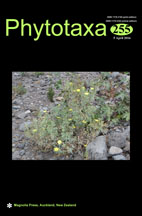Abstract
Chaetoceros is a large, mostly marine genus of diatoms that contains over five hundred species worldwide. Most species of Chaetoceros form chains, while a small minority are solitary in their growth form. Only seven Chaetoceros species have been reported in inland waters of Western North America, including C. amanita, C. elmorei, C. hohnii, C. muelleri, C. muelleri var. subsalsum, C. simplex and C. transisetus. A new Chaetoceros species, Chaetoceros coloradensis sp. nov. was found in Little Gaynor Lake in Boulder, Colorado, USA. We describe this new species using light and electron microscopy. Chaetoceros coloradensis has two setae per valve. Setae on opposite valves have different orientations in valve view, being offset by 30–45o from one another while all four setae lie in the same focal plane in girdle view. No processes exist on the valve surface of this new species. Individual gene and a concatenated sequence data set of LSU rDNA and SSU rDNA for C. coloradensis show that this species is allied with other solitary species in the genus. We compare and contrast the new species with all other twenty-one solitary species recorded, and comment on the section Simplicia, a group within Chaetoceros comprised exclusively of solitary species.

